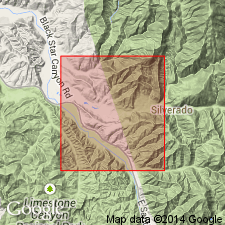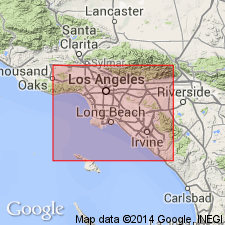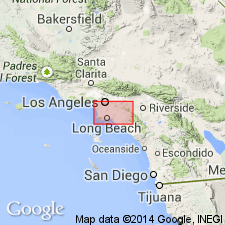
- Usage in publication:
-
- Williams formation
- Modifications:
-
- First used
- Biostratigraphic dating
- Dominant lithology:
-
- Sandstone
- AAPG geologic province:
-
- Peninsular Ranges province
Summary:
Pg. 380. Williams formation. Briefly described in "Generalized section of formations in the Santa Ana Mountains, California." Divided into two members, both new (ascending): Schulz member, arkosic sandstone with boulders, unfossiliferous, average 200 feet thick; Pleasants member, shaly sandstone with intercalated beds of limy sandstone, fossiliferous, about 320 feet thick. Unconformably overlies Ladd formation (new); unconformably underlies Eocene Martinez(?) formation. Age is Late Cretaceous based on molluscan fossils described in report.
Source: Publication; GNU records (USGS DDS-6; Menlo GNULEX); US geologic names lexicon (USGS Bull. 1200, p. 4242).

- Usage in publication:
-
- Williams formation
- Modifications:
-
- Named
- Biostratigraphic dating
- Dominant lithology:
-
- Conglomerate
- Sandstone
- AAPG geologic province:
-
- Peninsular Ranges province
Summary:
Named from characteristic exposures at type locality along Williams Canyon near its mouth, Santa Ana Mountains, Orange Co, CA. Comprises two members (ascending); Schulz conglomerate and sandstone member (also referred to as Schulz member) and Pleasants sandstone member. Formation is about 500 ft thick at type locality. Disconformably overlies Ladd formation. Unconformably underlies Martinez formation. Age is Late Cretaceous based on molluscan fossils listed and described in report.
Source: GNU records (USGS DDS-6; Menlo GNULEX).

- Usage in publication:
-
- Williams formation*
- Modifications:
-
- Adopted
- AAPG geologic province:
-
- Peninsular Ranges province
Summary:
Pleasants sandstone member of Williams formation is shown in stratigraphic column of northwestern Santa Ana Mountains as unconformably underlying Silverado formation (new). Also conglomerate of Schulz Ranch sandstone member of Williams formation directly underlies basal conglomerate of Silverado formation (new). Age is Late Cretaceous based on molluscan fossils (some listed).
Source: GNU records (USGS DDS-6; Menlo GNULEX).
For more information, please contact Nancy Stamm, Geologic Names Committee Secretary.
Asterisk (*) indicates published by U.S. Geological Survey authors.
"No current usage" (†) implies that a name has been abandoned or has fallen into disuse. Former usage and, if known, replacement name given in parentheses ( ).
Slash (/) indicates name conflicts with nomenclatural guidelines (CSN, 1933; ACSN, 1961, 1970; NACSN, 1983, 2005, 2021). May be explained within brackets ([ ]).

